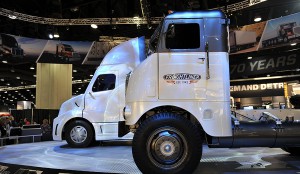 March 17, 2013 marked the end of an era as the last living pioneer of the development of the Freightliner truck passed away. Glenn W. Watkins (95) passed away peacefully with his family by his side in Clackamas, OR. He was the only child of Archie and Ellen Oslander Watkins, born October 13, 1917. Glenn married Marjorie Cauvel in 1940. She preceded him in death in 2001, after 61 years of marriage. He leaves behind three children, five grandchildren, six great-grandchildren, and his wife through commitment, Claudia Frykholm – as well as a lifetime of stories about trucks and trucking.
March 17, 2013 marked the end of an era as the last living pioneer of the development of the Freightliner truck passed away. Glenn W. Watkins (95) passed away peacefully with his family by his side in Clackamas, OR. He was the only child of Archie and Ellen Oslander Watkins, born October 13, 1917. Glenn married Marjorie Cauvel in 1940. She preceded him in death in 2001, after 61 years of marriage. He leaves behind three children, five grandchildren, six great-grandchildren, and his wife through commitment, Claudia Frykholm – as well as a lifetime of stories about trucks and trucking.
Glenn began his career in Spokane, WA, on May 1, 1939 at Consolidated Freightways (CF) as an apprentice mechanic. Glenn had been offered an office job at CF for 30 cents per hour, but he took the shop job instead, for 24 cents an hour, because he thought he would learn more in the shop than in the office. Glenn would later become Shop Foreman of CF in Spokane. Ken Self, another of the original pioneers of the Freightliner truck, was later hired at CF by Glenn. The two would work hand-in-hand the remainder of their professional careers on the development of the Freightliner truck and company.
Leland James, President of CF, had the desire for an aluminum cab-over-engine truck. Glenn and Ken Self were part of the original team of less than eight individuals to build and develop that truck, from scratch, on the shop floor of Consolidated Freightways, before there even was a Freightliner name. The trucks would be referred to as the “No Name” trucks. The name “Freightliner” was introduced in 1942. Glenn and Ken would go on to be the two longest serving pioneers of Freightliner from its official corporate beginning in 1942 until the time of its sale from Consolidated Freightways to Daimler Benz in 1981. Glenn retired from Freightliner the following year in 1982.
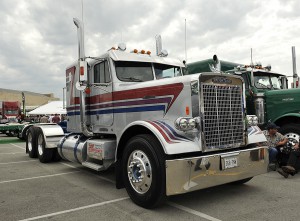 Lacking distribution capability and seeking higher volume to reduce production costs, CF entered into an agreement in 1951 to sell their trucks through the White Motor Company of Cleveland, OH and their dealer network in the United States and Canada. This relationship endured for the next quarter century, and the co-branded “White Freightliner” cab-over-engine models (COE) became a familiar sight on the highways across the continent.
Lacking distribution capability and seeking higher volume to reduce production costs, CF entered into an agreement in 1951 to sell their trucks through the White Motor Company of Cleveland, OH and their dealer network in the United States and Canada. This relationship endured for the next quarter century, and the co-branded “White Freightliner” cab-over-engine models (COE) became a familiar sight on the highways across the continent.
During his early years at Freightliner, Glenn moved from Spokane, WA to Portland, OR to serve as the Production Manager for the newly-created Freightliner Corporation. In 1953, Glenn was promoted from Production Manager at Freightliner to its Factory Sales and Service Manager in Portland, OR. In 1955, Glenn was promoted to its National Service Manager, where he traveled the entire country trouble-shooting trucks and training all of the dealers on the serviceability of the Freightliner truck. He was promoted to Vice President of Sales and Service for Freightliner in 1964.
Glenn frequently told stories about how he would be on the road for weeks at a time training the White dealers how to sell and service Freightliners. When business was bad, Glenn would be told not to come back to Portland until he had enough truck orders to keep the plant running. Tom Taylor, President of Freightliner in the 1950’s, would say to Glenn when he came back with a file-folder full of orders, “I don’t know what you are doing to get those orders, but keep doing it.” Tom Taylor was also one of the original pioneers, along with Ken Self and Glenn.
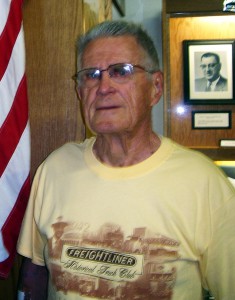 In 1976, Freightliner entered into a marketing agreement with Volvo Trucks to sell its product in the United States. Glenn was named Vice President of Sales and Service for Freightliner and Volvo USA Trucks at that time. As the company grew, the sales and service responsibilities were eventually separated into individual functions. At the time of Glenn’s retirement, he held the position of Vice President of Customer Relations.
In 1976, Freightliner entered into a marketing agreement with Volvo Trucks to sell its product in the United States. Glenn was named Vice President of Sales and Service for Freightliner and Volvo USA Trucks at that time. As the company grew, the sales and service responsibilities were eventually separated into individual functions. At the time of Glenn’s retirement, he held the position of Vice President of Customer Relations.
The original pioneer team at Freightliner developed a culture second to no other truck manufacturer. The pioneers were focused on lightweight trucks that were very serviceable. The trucks, designed initially by mechanics on the shop floor, were made efficiently and easy to work on. The Freightliner culture would revolve around being the “Hallmark of Custom Built Trucks” for many years. In the early days, many of the trucks were first developed from a customer’s need or idea. “No” was not part of the Freightliner culture or vocabulary – it was a word never heard if a customer asked for something special or custom. If a customer had a unique need, Freightliner would build it. Freightliner had trucks in the 1950’s that achieved four million miles. One truck, known as the Hyster Truck, is on display in the Smithsonian in Washington D.C. It was restored after going over four million miles, and is said to be one of the first Freightliner trucks ever sold to someone outside of Consolidated Freightways.
Glenn loved to tell the stories about the development of the Freightliner – and his trips involving sales and repairs. In Glenn’s early years with CF, they never retrieved a broken down truck with a wrecker. Glenn was a service specialist for CF and, back then, it was common for him to change rear-ends, clutches, radiators, and transmissions, all on the side of the road. During the winter months, it was the driver’s job to keep the fire going in the barrel to keep the two warm! Consolidated Freightways and Freightliner contributed more innovations during its developing years than any other trucking company. New Freightliner components, as Glenn would tell the story, would be tested for a million miles in the CF fleet before ever being introduced to the customer trucks.
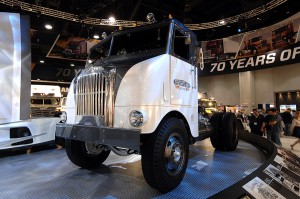 Glenn was in the Marines during WW-II for a very brief month. At that time, it was decided that Glenn’s talents would be better served at CF. Since Consolidated was hauling a considerable amount of tonnage for the war effort, it was decided that Glenn would be more valuable at home, keeping the CF fleet running.
Glenn was in the Marines during WW-II for a very brief month. At that time, it was decided that Glenn’s talents would be better served at CF. Since Consolidated was hauling a considerable amount of tonnage for the war effort, it was decided that Glenn would be more valuable at home, keeping the CF fleet running.
After retiring, Glenn was very influential and involved in opening the Pacific Northwest Truck Museum in Brooks, OR. The Museum has had three expansions since opening. Glenn remained on its Advisory Council up until his death. In 2007, Glenn was inducted into the Hall of Fame at the museum. After his retirement, Glenn also assisted Ken Self in the building of two miniature Freightliners. Ken Self had served as President of Freightliner and then as the Chairman of the Board prior to his retirement. The 2/3 size miniature Freightliners they built are on display at the museum, as well as a host of displays highlighting Glenn’s contributions to Consolidated, Freightliner, and the trucking industry, in general. Glenn continued to frequent the museum events up until the museum was closed for the winter in 2012. It had not yet reopened for 2013 before Glenn’s passing.
Glenn was of sound mind up until his passing. He was also a pretty rugged individual. Glenn’s hobbies included fishing and enjoying his beach home in Neahkahnie Beach, OR. Glenn and Margie traveled the world. One of his most interesting memories would be the 1968 flight he was aboard from Tampa, FL when it was hijacked to Cuba. After a three-hour layover, armed with Cuban Rum and Cuban cigars, he returned home safely. At the age of 92, Glenn also survived his patio canopy collapsing from the weight of snow on it, pinning Glenn under it. His physical health started a rapid decline in January of 2013. His stories and memories of CF, Freightliner, and the trucking industry will be remembered, but missed being told by Glenn himself.
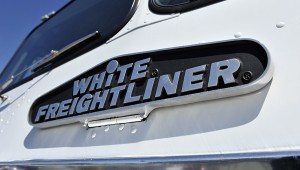 Glenn was very fond of his career with Freightliner. From its development on the shop floor of Consolidated Freightways, Glenn would rise from Apprentice Mechanic to Vice President of the famous nameplate. Prior to its sale to Daimler Benz, Freightliner had earned the reputation of the truck built to satisfy the driver, mechanic and owner, and was known as “The Efficient Machine” by most in the industry. The driver’s comfort was important for day-to-day operation, and mechanic ease was always a focus at Freightliner. Glenn told of sending his engineers to the shop floor to attempt to remove or replace a part. He would give stern orders after the hands-on-deck examination to improve its ease of repair, removal and replacement. By creating a truck that was appreciated by its drivers and functional for mechanics, Freightliner was “the truck of choice” for many years.
Glenn was very fond of his career with Freightliner. From its development on the shop floor of Consolidated Freightways, Glenn would rise from Apprentice Mechanic to Vice President of the famous nameplate. Prior to its sale to Daimler Benz, Freightliner had earned the reputation of the truck built to satisfy the driver, mechanic and owner, and was known as “The Efficient Machine” by most in the industry. The driver’s comfort was important for day-to-day operation, and mechanic ease was always a focus at Freightliner. Glenn told of sending his engineers to the shop floor to attempt to remove or replace a part. He would give stern orders after the hands-on-deck examination to improve its ease of repair, removal and replacement. By creating a truck that was appreciated by its drivers and functional for mechanics, Freightliner was “the truck of choice” for many years.
Glenn will be missed by all of his friends and family, but he also had a large following of Freightliner enthusiasts, and many of them had become close friends with Glenn. Ken Self, Glenn’s close friend and fellow pioneer who worked with Glenn at Consolidated Freightways and then Freightliner, preceded Glenn in passing 10 years ago, also in March. Ken’s son, Marv Self, was also a very good friend of Glenn’s near the end. Marv would frequently chauffeur Glenn to events, including the meetings at the Pacific Northwest Truck Museum.
A celebration of life was held for Glenn on April 12, 2013 at the Lake Grove Presbyterian Church in Lake Oswego, OR. Marv helped officiate at the event, and one of Glenn’s grandsons, Aaron Clodfelter, gave an awe-inspiring Eulogy that included a recap of many of Glenn’s stories. At the reception following the Church service, many other recollections of Glenn’s life were joyously shared. Although Freightliners do not always get the respect their history deserves from the younger generation today, they were undoubtedly the most trend-setting trucks of their day – and Glenn W. Watkins is largely responsible for that success. Our thoughts and prayers go out to all of his family and friends, as an era in trucking has come to an end.
EDITOR’S NOTE: We would like to thank Michael Gully of Quincy, IL for helping us with this story and making us aware of Glenn’s passing. The two were close friends. Michael is not only the owner of Gully Transportation, but he is also founder of the Freightliner Historical Truck Club. He also owns several neat old Freightliners!

2 Comments
Nice article. Thanks.
Thanks for the story ..Now i know the rest …